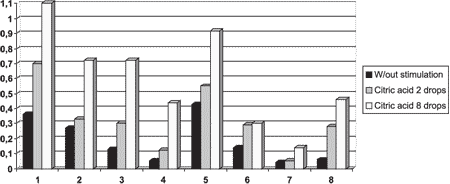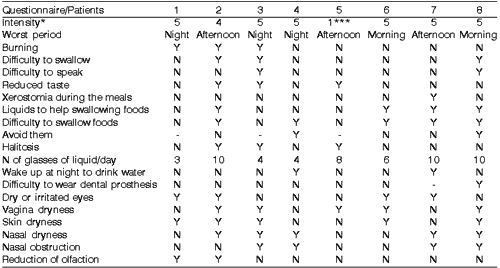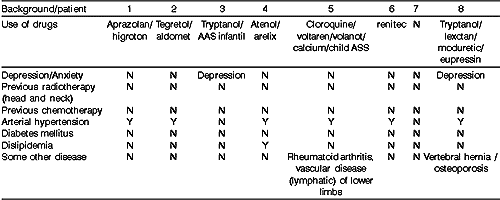

Year: 2002 Vol. 68 Ed. 5 - (4º)
Artigo Original
Pages: 624 to 628
Correlation between xerostomic level and the result of the sialometry in patients with Sjögren Syndrome
Author(s):
Gustavo Polacow Korn 1,
Daniella Belotto Pupo 2,
Araken Quedas 3,
Ivo Bussoloti Filho 4
Keywords: xerostomia, Sjögren syndrome, sialometry.
Abstract:
Introduction: Xerostomia, a subjective dry mouth feeling, may be associated to several diseases and systemic disorders incluiding Sjögren syndrome. Study design: Clinical prospective. Material and method: We conducted an eight Sjögren syndrome patients study with xerostomia complains. They were asked to answer a group of questions related to commonly xerostomia signs and symptoms and had, in addition, a sialometry performed in order to assess wether any correlation could be found between both kinds of observations. Results: In spite of variable degrees of oral symptoms present in all eight patients, saliva flow decrease could only be documented in three. Conclusion: Therefore, in our observation, no correlation could be found between oral symptoms magnitude and amount of saliva secreted in Sjögren patients.
![]()
Introduction
Xerostomia (xeros = dry , stoma= mouth), may be found in ambulatory clinic patients of any age, mainly the elderly. It is a subjective feeling of dry mouth due to various etiologies that may or may not result in the reduction or interruption of salivary secretion. It may become a very unpleasant experience for the patient 1. Xerostomia may or may not be associated to various conditions and/or systemic alterations, among which Sjögren's Syndrome 1-15, head and neck radiotherapy, hormonal changes (including menopause) 16-21, hypophyseal alterations, hypothyroidism 21 and diabetes 23-28. It is frequently a co-morbid condition of patients with advanced cancer 29. Xerostomia may accompany certain conditions as a treatment side-effect 30. There are roughly 500 drugs that may lead to xerostomia. The most frequent ones are anti-depressant and anti-histaminic drugs, diuretics, anti-parkinsonian, anti-psychotic, anti-hypertensive, anti-cholinergic and anti-neoplastic drugs 31.
The higher incidence of systemic conditions and the frequent utilization of drugs among the elderly explain the high rate of xerostomia in this age group 32.
Sjögren's Syndrome (SS) is an autoimmune disease of exocrine glands that affects mainly salivary and lacrimal glands. It may occur alone (primary SS) or associated with other autoimmune conditions (secondary SS) 33.
Sjögren's Syndrome consists of a focal inflammatory infiltrate that affects glandular function that in turn may lead to xerostomia and xerophthalmia. Approximately 90% of patients with Sjögren's Syndrome are women, with an average age of 50 years upon diagnosis 34.
Characteristic signs and symptoms reported are burning mouth 18,20,23, oral discomfort, pain, mucositis, dysgeusia (tasting disorder), increased incidence of cavities and periodontal disease 10,11,20,24, enlargement of greater salivary glands 24,27 and candidiasis 4,14. Discomfort caused by acid foods and difficulties in eating dry foods have been reported 14.
Regarding the diagnosis of Sjögren's Syndrome, one of the most accepted definitions is that of the European Community Study Group on Diagnostic Criteria for Sjögren's Syndrome 33 based on six criteria: (1) presence of one of the following symptoms in eyes: persistent and daily xerophthalmia for more than three months, feeling of sand in eyes or need to use eye drops to replace tears more than three times a day, (2) one of the following oral symptoms: dry mouth for more than three months, presence of persistent or recurring swelling of salivary glands for more than three months (repetitive acute sialoadenitis) or frequently having to drink to help swallowing dry foods; (3) positive result for at least one of following tests: a) Shirmer's test (< or = 5 mm in 5 minutes); b) Bengal Rose > or = 4; (4) histologic characteristics, that is, pack score > or = 1 on lesser salivary glands biopsy (pack is defined as at least 50 mononuclear cells together and the score is defined as the number of 4 mm2 packs in the glandular tissue); (5) affected salivary gland on at least one of the following tests: salivary scintigraphy, parotid sialography, sialometry with non-stimulated salivary flow; (6) presence of at least one of the auto-antibodies: anti-SS-A or anti-SS-B, anti-nucleus factor or rheumatoid factor. Four positive criteria in 6 are necessary in order to reach the diagnosis of primary SS. Three positive criteria, including (1) or (2), associated to two other criteria, excluding number (6) are necessary in order to reach a diagnosis of secondary SS.
Objective
To examine the association between subjective xerostomia (by means of a questionnaire) and sialometry, in patients with Sjögren's Syndrome.
Material and methods
The study comprised 8 patients with Sjögren's Syndrome and with a complaint of xerostomia that sought the Stomatology Outpatient Clinic of the Otolaryngology Department from February to June 2001. Ages ranged between 39 and 72 (average of 62 years) and all patients were women.
Patient assessment was based on presenting signs and symptoms and sialometry. Patients answered a first questionnaire regarding: intensity of xerostomia, worst period (morning, afternoon or night), burning, difficulty in chewing, difficulty in speaking, decrease in taste, xerostomia during meals, need to drink liquids to swallow food, difficulty in swallowing food, if certain foods are avoided, halitosis, number of glasses of liquid per day, waking up at night to drink water, difficulty in wearing dental prostheses, dry or irritated eyes, dry vagina, or skin, or nose, nasal obstruction and decrease in olfaction. The second questionnaire referred to personal background: medication used, depression or anxiety, previous radiotherapy (head or neck), previous chemotherapy, hypertension, diabetes mellitus, dislipidemia or other conditions. Assessment of the first questionnaire was based on presence (Y= yes) or absence (N= no) of symptoms, and the intensity by a score from 1 to 5 (1= very little, 2= little, 3= moderate, 4= important, 5= very important). Evaluation criteria were the same for the second questionnaire.
Sjögren's Syndrome was diagnosed through the criteria of the European Community Study Group on Diagnostic Criteria for Sjögren's Syndrome .
Sialometry was performed as follows: we deposited two cotton balls, previously weighed on a high precision scale, on patients' mouth floor. Cotton balls remained during two minutes, and were weighed again after they were removed. The difference between pre and post tests was considered as the salivary flow during the period. Three series of sialometry were performed for each patient: the first without stimulus; the second flow was stimulated with two drops of 2.5% citric acid; for the third we performed a super-stimulation, putting two drops every 30 seconds, totaling eight drops in two minutes. Sialometry results were measured in ml/min.
Graph 1. Comparison between sialometry without stimulation and with citric acid 2 and 8 drop stimulation.
Patients were assessed as to presenting signs and symptoms and result of sialometry, seeking a relationship between them.
Results
We present next the results of the first questionnaire (Table 1), personal background (Table 2), sialometry (Table 3), and graph 1, referring to sialometry.Table 1. First questionnaire
* intensity was defined from a 1 to 5 score (1. Very little; 2. = little, 3= moderate, 4= important, 5= very important).
** N - no, Y - yes
*** patient referred thick saliva.
Table 2. Background
* N - no, Y - yes
Table 3 . Sialometry
* value in ml/min.
Discussion
Results obtained in the present study were based on Sreebny et al, 1988 35, who submitted 529 patients to sialometry in order to determine what figures defined xerostomia. Thus, a salivary flow (obtained without stimulus) below or equal to 0.1ml/min with xerostomia along with a subjective feeling of dry mouth were considered abnormal.
Based on these criteria and the analysis of patient questionnaires, we observed that the intensity/quantity of oral complaints is not directly related to patient salivary flow. Only 3 patients (4, 7 and 8) had decreased flow (abnormal), while 100% referred variable extent of oral symptoms. These findings are similar to those observed by Field et al, 1997 23 in a study performed with 100 patients with xerostomia. Subjects with greatly decreased salivary flow may not complain of dry mouth, while those with abundant salivation may refer xerostomia. The quality of saliva is an essential factor, because changes in composition or viscosity may lead to this kind of complaint 23. We therefore, believe that the quality of saliva, mainly of the mucoid component, may be responsible for complaints of patients that do not have salivary hypo-flow. Similarly, small increases in salivation usually benefit substantially patients that produce little or no saliva, although equivalent increases in patients with higher salivary flow may not result in any improvement 36. This is why although citric acid does not stimulate greatly, it may bring a substantial improvement to many patients.
Results obtained in our questionnaires have also allowed us to verify that there is no standardization in relation to complaints referred by patients. Oral complaints varied greatly among patients, so anamnesis of patients with xerostomia should be extensive, including extra-oral complaints, which is in agreement with the study of Herrera et al, 1998 37. Extra-oral signs and symptoms were present in all patients in this study, a common event in cases in which xerostomia is part of a systemic picture, such as in auto-immune conditions, according to Nahri, et al, 199922 and Sreebny et al, 1989 38. Six patients used drugs potentially capable of decreasing salivary flow. Using various drugs at the same time and longer treatments usually trigger more severe cases of xerostomia. Thus, xerostomia is more frequent and a common cause for abandoning drug treatment among the chronically ill and the elderly. It is essential to point out that dry mouth induced by drugs is always reversible 31.
The usefulness of determining sialometry standards that characterize hypo-salivation is debatable. The major contribution of sialometry may be that of allowing the analysis of the same patient being treated for xerostomia, monitored through serial sialometries.
The results of the present study are partial ones, because these patients will be reassessed after 6 months of treatment with citric acid and artificial saliva. Another study in progress in our Department refers to the utilization of scintigraphy to assess salivation of patients with Sjögren's Syndrome.
Conclusion
According to our study, there was no relationship between patient complaints and sialometry. Moreover, a single sialometry does not suffice to define xerostomia, and more than one test is necessary to characterize the condition, through patient follow-up.
References:
1. Bivona PL Xerostomia. A common problem among the elderly N. Y. State Dent. J., USA, v. 64, n. 6, p. 46-52, Jun-Jul 1998.
2. Anon. New studies on Sjöegren's syndrome. Esencia Odontol., v.58, n. 9, 1994.
3. Cobos Sergovia, L Martínez Del Pinto, F - Oral manifestations of the Sjögren's syndrome. Rev. Hosp. Clin. Univ. Chile, Chile, v. 3, n. 3/4, p. 114 - 120, 1992.
4. Dihlangeli, Roberto; Costa, Sady Selaimen de. Xerostomia: ambulatorial management. Rev. Bras. Med. Otorrinolaringol., Brasil, v.2 n. 4, p. 252-4, Jul 1995.
5. Fox, Robert I Sjögren's syndrome. Controversies and progress. Clin. Lab. Med., USA, v. 17, n. 3, p. 431-44, Sep. 1997.
6. Hay EM, Thomas E, Pal B et al. Weak association between subjective symptoms or and objective testing for dry eyes and dry mouth: results from a population based study. Ann. Rheum. Dis., England, v. 57, n. 1, p. 20-4, Jan 1998.
7. Hernández V, Carmen, Saenz B et al. New method to evaluate xerostomia in Sjögren's syndrome Rev. Med. Chile, Chile, v. 119, n. 6, p. 677-9, Jun 1991.
8. Jensen JL, Uhlig T, Kvien TK et al. Characteristics of rheumatoid arthritis patients with self-reported sicca symptoms: evaluation of medical, salivatory and oral parameters. Oral Dis., England, v. 3, n. 4,p. 254-61 Dec 1997.
9. Lozano Alcázar, Jaime, Bergs Ahumada, Marcela. A comparative evaluation of the keratoconjuntivitis sicca treatment between iodine and bromhexisine, Bol. Hosp. Oftalmol. Nuestra Señora de La Luz, v. 42, n. 148, p. 51-6, Jul-Sep 1990.
10. Nelson JD, Friedlaender M, Yeatts RP et al. Oral pilocarpine for symptomatic relief of keratoconjunctivitis sicca in patients with Sjögren's syndrome. Adv. Exp. Med. Biol., USA, v. 438, p.979-83, 1998.
11. Papas AS, Fernadez MM, Castano RA et al. Oral pilocarpine for symptomatic relief of dry mouth and dry eyes in patients with Sjögren's syndrome. Adv. Exp. Med. Biol., USA, v. 438, p.973-8, 1998.
12. Rhodus NL. Oral pilocarpine HCL stimulates labial (minor) salivary gland flow in patients with Sjögren's syndrome. Oral Dis., England, v.3, n. 2, p.93-8, Jun 1997.
13. Sanchez Contreras A, Chalem BF. Primary Sjögren syndrome : clinical and immunological aspects. Acta Med. Colomb., Colombia, v.12, n. 1, p. 3-14, Jan-Feb 1987.
14. Soto-Rojas AE, Villa AR, Sifuentes-Osornio J et al. Oral manifestations in patients with Sjögren's syndrome. J. Rheumatol., Canada, v. 25, n. 5, p. 906-10, May 1998.
15. Trentin Filho FJ, Staub HL, Mhlen, Carlos Alberto von et al. Evaluation of non-stimulated salivar secretion in reumathic patients with xerostomia by saxon test. Rev. Bras. Reumatol., Brasil, v. 33,n. 5, p. 165-8, Sep-Oct 1993.
16. Ben Aryeh H, Gottlieb I Ish-Shalom S, David D et al. Oral complaints related to menopause. Maturitas, Ireland, v. 24, n. 3, p. 185-9, Jul 1996.
17. Forabosco A, Criscuolo M, Coukos G et al. Efficacy of hormone replacement therapy in postmenopausal women with oral disconfort. Oral Surg. Oral Med. Oral Pathol., v. 73, n. 5, p. 570-4, May 1992.
18. Hakemberg M, Berggren U, Hägglin C et al Reported burning mouth symptoms among middle-aged and elderly women. Eur. J. Oral Sci., Denmark, v. 105, n. 6, p. 539-43, Dec 1997.
19. Ship JA, Patton LL, Tylenda CA. An assessment of salivatory function in healthy premenopausal and postmenopausal females. J. Gerontol., USA, v. 46, v. 1, p. m11-15, Jan 1991.
20. Trombelli L, Mandrioli S, Zangari F et al. Oral symptoms in the climateric. A prevalence study. Minerva Stomatol., Italy, v.41, n. 11, p. 507-13, Nov 1992.
21. Wardrop RW, Hailes J, Burger H et al. Oral Surg. Oral Clin. Oral Pathol., USA, v. 67, n. 5, p. 535-40, May1998.
22. Markitziu A, Lustmann J, Uzieli B et al. Oral Surg. Oral Clin. Oral Pathol., USA, v. 75, n. 3, p. 318-22, May1993.
23. Field EA, Longman LP, Bucknall R et al. The establishment of a xerostomia clinic: a prosperative study. Br. J. Oral Maxilllofac. Surg., England, v. 35, p. 96-103, Apr 1997.
24. Greenspan, D Xerostomia: diagnoses and management Oncology ( Huntingt), USA, v. 10, p. 7-11, Mar 1996.
25. Kimura I, Miyamoto H., Chen FJ et al. The streptozocin-diabetic state depresses saliva secretion stimulated by pilocarpine and noradrenaline in mice. Biol Pharm Bull, Japan, v. 19, p. 384-7, Mar 1996.
26. Longman LP, Higham SM, Rai K et al. Salivatory gland hypofunction in elderly patients attending a xerostomia clinic. Gerodontology, England, v. 12, p. 67-72, Dec 1995.
27. Quirino MR, Birman EG, Paula CR. Oral manifestations of diabetes mellitus in controlled and uncontrolled patients. Braz. Dent. J., Brasil, v. 6, p. 131-6, 1995.
28. Zachariasen RD. Xerostomia and the diabetic patient. J. Gt. Houst Dent. Soc., USA, v. 67, p. 10-13, Feb 1996.
29. Davies NA. The management of xerostomia: a review. Eur. J. Cancer Care, England,v. 6, n. 3, p. 209-14, Sep 1997.
30. Pollock BG, Mulsant BH, Nebes R et al. Serum anticholinergicity in elderly depressed patients treated with paroxetine or nortriptyline. Am. J. Psychiatry, v. 155, n. 8, p. 1110-2, Aug 1998.
31. Sreebny, Leo M, Broich G. Xerostomia: dry mouth. In: SREENBNY, Leo Morris. The salivatory system. Boca Raton : CPC, 1987., 233 p, cap. 9
32. Pajukoshi H, Meurman JH, Snellman-Gröhn S et al. Salivatory flow and composition in elderly patients referred to an acute care geriatric ward. Oral Surg. Oral Med. Oral Pathol. Oral Radiol. Endod., USA, v. 84, p. 265-71, Sep 1997.
33. Vitali C; Bombardieri S; Moutsopoulos HM et al. - Preliminary criteria for the classification of Sjögren's syndrome - Results of a prospective concerted action supported by the European Community. Arthritis Rheum., v.36,n.3, p.340-8, 1993.
34. Bell M; Skari A; Bookman A et al. Sjögren's Syndrome: A critical rewiewof clinical management. J Rheumatol., v.26,n.3, p.2051-61, 1999.
35. Sreebny M & Valdini A - Xerostomia. Part I: relationship to other oral symptoms and salivary gland hypofunction. Oral Surg Oral Med. Oral Pathl.,v.66, p.451-8, 1988.
36. Johnson JT; Ferretti GA; Nethery J; Valdez IH; Fox PC; NG, D; Muscoplat CC; Gallagher SC - Oral pilocarpine for post-irradiation xerostomia in patients with head and neck cancer. N. Engl. J. Med., v.329, p.390-5, 1993.
37. Herrera JL; Lyons MF; Jonson LF - Saliva: its role in health and disease. J. Clin. Gastroenterol., v.10, n.5, p. 569-78, 1998.
38. Nahri TO; Meurman JH; Ainamo A - Xerostomia and hyposalivation. Causes, consequences and treatment in the eldery. Drugs Aging, v.15, n.2, p. 103-16, 1999.
39. Sreebny M & Valdini A; Yu A - Xerostomia. Part II: relationship to non oral symptoms, drugsand diseases. Oral Surg Oral Med. Oral Pathl.,v.68, p.419-27, 1989.
1 Resident Physician, Department of Otorhinolaryngology, Santa Casa de São Paulo.
2 Master studies under course, Department of Otorhinolaryngology, Santa Casa de São Paulo.
3 Resident Physician, Department of Otorhinolaryngology, Santa Casa de São Paulo.
4 Joint Professor, Department of Otorhinolaryngology, Santa Casa de São Paulo.
Address correspondence to: R. Dr. Chibata Miyakoshi, 300 ap 111-B Paraíso do Morumbi - Cep 05750-170 - São Paulo -SP - Tel (55 11) 91893485
Affiliation: Department of Otorhinolaryngology, Santa Casa de São Paulo.
Article submitted on January 24, 2002. Article accepted on May 16, 2002



